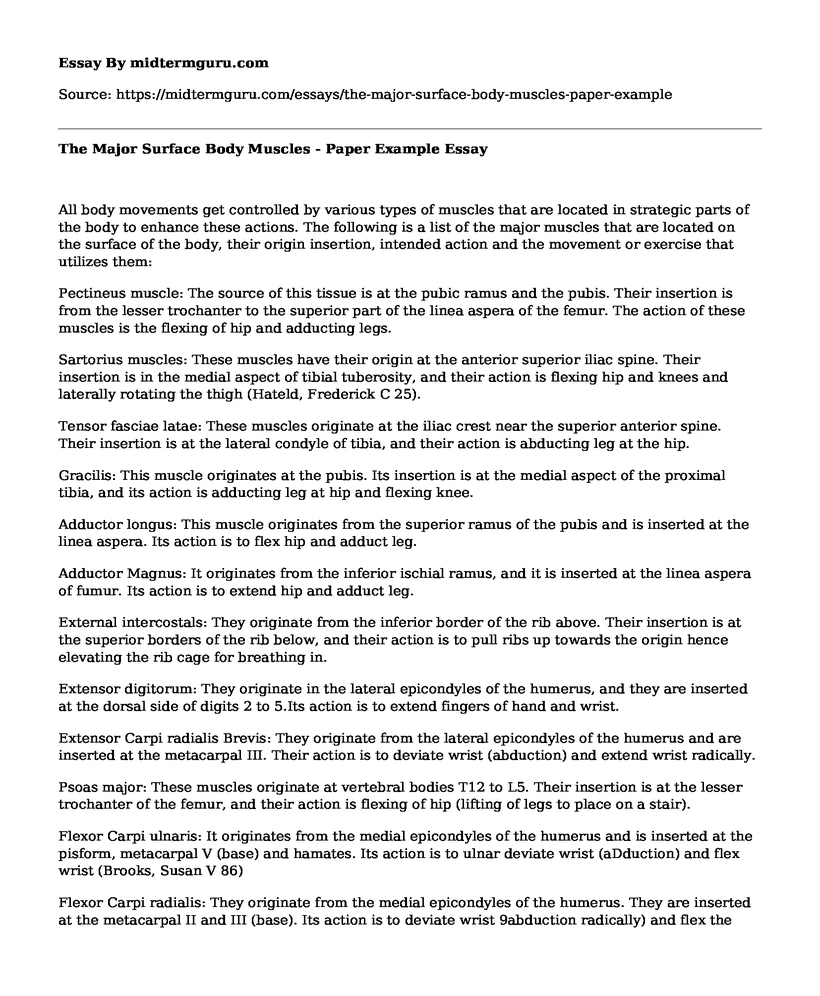All body movements get controlled by various types of muscles that are located in strategic parts of the body to enhance these actions. The following is a list of the major muscles that are located on the surface of the body, their origin insertion, intended action and the movement or exercise that utilizes them:
Pectineus muscle: The source of this tissue is at the pubic ramus and the pubis. Their insertion is from the lesser trochanter to the superior part of the linea aspera of the femur. The action of these muscles is the flexing of hip and adducting legs.
Sartorius muscles: These muscles have their origin at the anterior superior iliac spine. Their insertion is in the medial aspect of tibial tuberosity, and their action is flexing hip and knees and laterally rotating the thigh (Hateld, Frederick C 25).
Tensor fasciae latae: These muscles originate at the iliac crest near the superior anterior spine. Their insertion is at the lateral condyle of tibia, and their action is abducting leg at the hip.
Gracilis: This muscle originates at the pubis. Its insertion is at the medial aspect of the proximal tibia, and its action is adducting leg at hip and flexing knee.
Adductor longus: This muscle originates from the superior ramus of the pubis and is inserted at the linea aspera. Its action is to flex hip and adduct leg.
Adductor Magnus: It originates from the inferior ischial ramus, and it is inserted at the linea aspera of fumur. Its action is to extend hip and adduct leg.
External intercostals: They originate from the inferior border of the rib above. Their insertion is at the superior borders of the rib below, and their action is to pull ribs up towards the origin hence elevating the rib cage for breathing in.
Extensor digitorum: They originate in the lateral epicondyles of the humerus, and they are inserted at the dorsal side of digits 2 to 5.Its action is to extend fingers of hand and wrist.
Extensor Carpi radialis Brevis: They originate from the lateral epicondyles of the humerus and are inserted at the metacarpal III. Their action is to deviate wrist (abduction) and extend wrist radically.
Psoas major: These muscles originate at vertebral bodies T12 to L5. Their insertion is at the lesser trochanter of the femur, and their action is flexing of hip (lifting of legs to place on a stair).
Flexor Carpi ulnaris: It originates from the medial epicondyles of the humerus and is inserted at the pisform, metacarpal V (base) and hamates. Its action is to ulnar deviate wrist (aDduction) and flex wrist (Brooks, Susan V 86)
Flexor Carpi radialis: They originate from the medial epicondyles of the humerus. They are inserted at the metacarpal II and III (base). Its action is to deviate wrist 9abduction radically) and flex the wrist.
Triceps brachii: They originate from the medial head; the posterior distal shaft of humerus, the long head; infra glenoid tubercle of the scapula and lateral head; the posterior proximal shaft of the humerus. They are inserted at the olecranon of the ulna, and their action is to extend forearm at the elbow (Gosling, J. A., Harris, P. F., Humpherson, J. R., Whitmore I., & Willan P. L. T 186).
Biceps brachii: They originate from the long head; supraglenoid tubercle of the scapula and the short head; coracoids process of the scapula. They are inserted at the radial tuberosity, and their action is to flex elbow and supinate forearm (scooping water in your hands to drink) (Hateld, Frederick C 25)
Brachial: Its action is to flex elbow (bringing food to your mouth). It is inserted into the coronoid process of the ulna, and it originates from anterior distal of the humerus.
Work Cited
Hateld, Frederick C. PhD, Fitness: The Complete Guide: Ofcial Text for ISSA Certied Fitness Trainer Course Edition 9.0, p.81, 90, 182-300 Jarmey, Chris, The Concise Book of Muscles, Second Edition, p. 3-188
Brooks, Susan V. (2003-12-01). "Current topics for teaching skeletal muscle physiology". Advances in Physiology Education. 27 (1-4): 171182. doi:10.1152/advan.00025.2003. ISSN 1043-4046. PMID 14627615.
Gosling, J. A., Harris, P. F., Humpherson, J. R., Whitmore I., & Willan P. L. T. 2008. Human Anatomy Color Atlas and Text Book. Philadelphia: Mosby Elsevier. page 200
Cite this page
The Major Surface Body Muscles - Paper Example. (2021, Jul 02). Retrieved from https://midtermguru.com/essays/the-major-surface-body-muscles-paper-example
If you are the original author of this essay and no longer wish to have it published on the midtermguru.com website, please click below to request its removal:
- Paper Example on Pathophysiology of Asthma
- Lessen Infection at Surgical Site by Washing Hand with Antiseptic Prior and After Surgery
- Research Paper on Gastric Cancer
- Essay Sample on Breast Cancer and Prostate Cancer Disorders
- Humanitarian Assistance: Research Proposal
- Essay Sample on Nurse Manager Leadership Strengths
- Buchanan Unites Conservatives on Moral Issues in Bush Speech - Essay Sample







